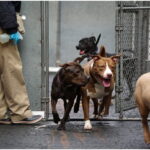For a place often associated with confinement, suffering and death, the city animal shelter in Manhattan was a pretty happy spot last Friday afternoon, at least in the backyard.
A half-dozen pit bull mixes chased one another across an asphalt run behind the shelter, a cinder-block bunker on East 110th Street in Harlem, dancing and wrestling in midair.
Elf, a brown-and-white dog, chest-bumped with Cupcake, who was sporting a purple collar. Cupcake leapt over Ezra. An “enrichment facilitator” stood by with a spray water bottle, in case her charges got too exuberant.
This was “puppy playgroup,” one of many programs begun since 2014 at the Animal Care Centers of NYC (formerly Animal Care and Control), the often-criticized nonprofit agency that runs New York City’s three animal shelters.
The changes have been yielding results, agency officials say.
Euthanasia rates dropped sharply in 2015, down 36 percent for dogs and 25 percent for cats, according to statistics the agency plans to release at its annual board meeting on Friday. Adoptions rose by 17 percent.
In 2003, the shelters killed more than 60 percent of the dogs and the cats they took in. That number is down to 13 percent now.
Still, last year, over 3,000 cats and nearly 1,000 dogs were put to death at the overcrowded shelters. And private rescue groups, which adopt more than half of the shelters’ animals, say that all too often, animals that are brought in healthy get sick and either die or saddle their rescuers with high veterinary bills.
Animal Care Centers “tries to do the right thing,” said Councilman Corey Johnson, a Manhattan Democrat who is chairman of the Health Committee. “But they’re extremely underfunded and don’t have the right facilities.”
But there is fresh hope on that front, too: A design firm the city hired last year is scouting sites to build full-service shelters in the Bronx and Queens, something advocates, lawmakers and Animal Care Centers itself have long urged. The existing shelters, in Brooklyn, Manhattan and Staten Island, are also being upgraded or expanded.
Animal advocates and agency officials alike said new shelters could go far to alleviate overcrowding and check the spread of disease.
“We really welcome the day that those two shelters are built,” Risa Weinstock, the executive director of Animal Care Centers, said. “In the meantime we still have those challenges. But we’ve proved that we’re an organization worth investing in.”
Since 2007, the city has increased Animal Care Centers’ budget to about $13 million from $7 million.
The money had been put to use: new “mobile adoption centers” — vans from which more than 700 animals were adopted last year; a food pantry for pets in the Bronx; a behavioral staff of 22 that, among other things, runs the playgroups, which the shelter says improve the dogs’ immunity and make them more docile and adoptable when they return to their kennels. (Coming soon to the backyard run in Manhattan: artificial grass.)
The shelters had also added admissions counselors who, since 2014, have persuaded about 1,700 owners to keep their pets rather than surrender them by connecting the owners with medical grants, low-cost boarding or behavioral advice. So often, people come in and think that’s their only option.
The agency has worked on its image as well. Last year it changed its name, though it does not yet have the money to alter its signs.
Ms. Weinstock said she hoped the $5 million adoption center the city is planning to build beside the Manhattan shelter would have its entrance on 109th rather than 110th Street, to make it seem more separate from the shelter itself.
“We want the public to see us the way they see Animal Haven and A.S.P.C.A. — warm and friendly,” she said.
Warm and friendly can be tough to pull off when the agency must take every animal that is brought in — something Animal Care Centers’ contract with the city requires — and it does not have the room or the capability to treat them all.
“Caring for 35,000 animals is an impossible task,” Ms. Weinstock said.
In 2015, the shelters euthanized 15 percent of cats and 9 percent of dogs. (The shelters also take in hundreds of rabbits but do not euthanize any unless it is medically necessary.)
The daily “at-risk” lists that the agency puts out — candidates for euthanasia if not adopted by the next morning — often include animals who were listed as “normal” on an initial medical exam and as having “major conditions” days later. Upper respiratory infections like kennel cough spread quickly through the shelters and can easily turn into pneumonia.
“All the brand-new dogs and the sick dogs are traveling in the same hallway all the time,” said a volunteer at the shelter in East New York, Brooklyn, who declined to give her name for fear of losing her post. “If a dog has kennel cough and they’re in the adoptions room, sometimes it’s not recognized for a day or so.”
Doug Halsey, the president of one rescue group, Ready for Rescue, told the story of Muska, a tortoiseshell cat who was counted in Animal Care Centers’ statistics as an animal saved.
She entered the Manhattan shelter healthy in November and came down with a crippling upper respiratory infection the day after Ready for Rescue took her from the shelter, Mr. Halsey said. She died, but only after Ready for Rescue had run up $5,000 in veterinary bills.
“The euthanasia rate is down while rescues bear the burden of taking on all the sick and hard-to-adopt animals,” he said.
A letter Animal Care Centers sent to rescue groups last summer was matter-of-fact about the situation, noting that if an animal pulled from a shelter “is already sick or becomes sick and requires hospitalization, please understand that medical care of several thousand dollars can be expected.”
The stubbornness of contagion is one of the main reasons advocates are pinning their hopes on the new shelters.
“By building facilities in all the boroughs,” said Christopher Mancuso of Staten Island Hope Animal Rescue, which accepted 2,300 of Animal Care Centers’ 20,000 cats in 2015, “that will give them more space to isolate the sicker ones and the animals will come out of there healthier.”
The current city budget includes $1.4 million to start the siting process, and Christopher Miller, a spokesman for the health department, said a design firm had begun identifying possible sites and researching zoning and building requirements.
Councilman Paul Vallone, a Queens Democrat and the prime sponsor of a 2014 bill that would require the city to build the shelters, said he hoped the budget the mayor was expected to propose on Thursday would have money to begin construction. “If you don’t get the fiscal commitment you’re just creating another empty promise,” Mr. Vallone said.
Amy Spitalnick, a spokeswoman for the office of Mayor Bill de Blasio, said that finding sites for the buildings had to come first. She said the mayor, a Democrat, “has made a major commitment to creating new animal shelters in Queens and the Bronx.”
In the meantime, the animals keep coming. One Saturday afternoon this month, David Santiago led his two pit bulls into the Manhattan shelter. Then he left, alone. His landlord in the South Bronx, he explained, had told him he could not keep the dogs. They were 2 years old, and he had raised them from puppies.
“They’re like part of your family,” Mr. Santiago said. “The hardest part is that you know what happens to them if they don’t get adopted.”



